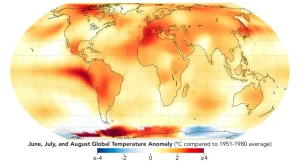
The Earth has just experienced the hottest twelve consecutive months on record, according to the world’s top meteorological organizations, with January 2024 capping the record-hot run as not only the warmest January since 1850, but also the eighth consecutive record-breaking month on record. This continues the ongoing global warming-driven climb of temperatures that has prompted forecasters to predict, even this early in the year, that 2024 will be another one for the history books.
“Globally, the last 12 months were warmer than any previous consecutive twelve months, with a temperature 0.64°C (1.15°F) above the 1991-2020 average. The next warmest such period was the calendar year of 2023,” according to a press release from the European Union’s Copernicus Climate Change Service, referring to the period spanning February 2023 to January 2024.
It’s important to bear in mind that this temperature departure of 0.64°C is only in comparison to the temperatures of the past three decades: compared to the twentieth century average the National Oceanic and Atmospheric Administration (NOAA) estimates that the last twelve months were 1.22°C (2.20°F) hotter than they should be, while being 1.52°C (2.74°F) higher than the 1850-1900 level, according to Copernicus.
“This does not mean that the world has exceeded the lower-level target of 1.5° Celsius above the pre-industrial era referred to in the Paris Agreement on Climate Change,” a press release posted by the World Meteorological Organization (WMO) cautioned. “The Paris Agreement refers to long-term warming over many years rather than monthly or annual exceedances.”
In addition to January 2024’s record-breaking surface temperature departure of 1.27°C (2.29°F) over the twentieth century average, sea surface temperatures continued their own record-breaking streak for the tenth consecutive month, helped in no small part by an ongoing El Niño event in the equatorial Pacific.
NOAA predicts that there is a 79 percent chance that the region’s temperatures will even out into an ENSO-neutral state somewhere between April and June, with a 55 percent chance of a cooler La Niña state developing by August, although it remains to be seen as to whether or not either of those conditions will be enough to prevent 2024 from being another record-breaking year.
Subscribers, to watch the subscriber version of the video, first log in then click on Dreamland Subscriber-Only Video Podcast link.